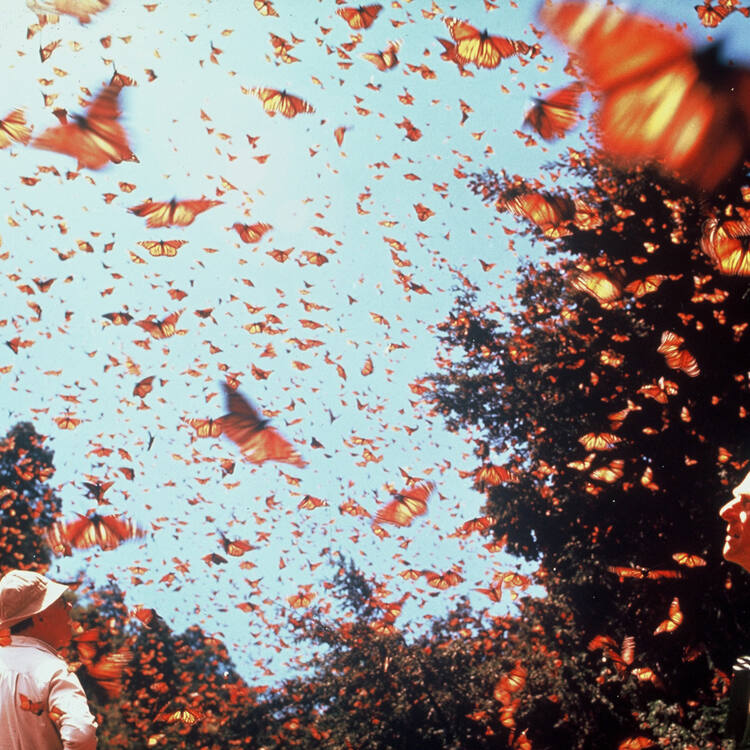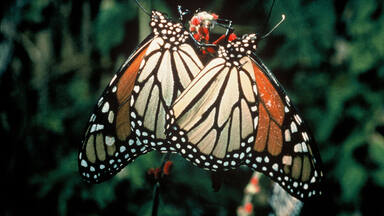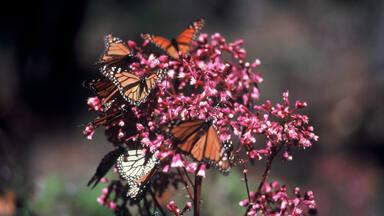Monarch Butterfly Biosphere Reserve
Monarch Butterfly Biosphere Reserve
The 56,259 ha biosphere lies within rugged forested mountains about 100 km northwest of Mexico City. Every autumn, millions, perhaps a billion, butterflies from wide areas of North America return to the site and cluster on small areas of the forest reserve, colouring its trees orange and literally bending their branches under their collective weight. In the spring, these butterflies begin an 8 month migration that takes them all the way to Eastern Canada and back, during which time four successive generations are born and die. How they find their way back to their overwintering site remains a mystery.
Description is available under license CC-BY-SA IGO 3.0
Réserve de biosphère du papillon monarque
La réserve de biosphère du papillon monarque est située dans une chaîne de montagnes à environ 100 km au nord-ouest de Mexico. Sur ces 56 259 ha, chaque automne, des millions, voire un milliard, de papillons provenant des vastes espaces nord-américains s’amoncellent sur de petites parcelles forestières de la réserve, colorant les arbres en orange et faisant ployer les branches sous leur poids collectif. Au printemps, ces papillons reprennent une migration de 8 mois, vers l’est du Canada avant de revenir au Mexique. Durant cette période, quatre générations successives naîtront et mourront. Nous ignorons encore aujourd’hui comment ils parviennent à retrouver leur chemin vers le site d’hivernage.
Description is available under license CC-BY-SA IGO 3.0
محمية المحيط الحيوي – الفراشة الملكة
تقع المحمية في سلسلة جبلية على مسافة 100 كلم تقريباً من شمال غرب المكسيك. في كل خريف، تصل إليها من فضاءات أمريكا الشمالية الرحبة ملايين الفراشات، حتى مليار فراشة، لتتكدّس على مساحتها البالغة 259 56 هكتاراً، في أجزاء صغيرة من الموقع، فتلوّن الأشجار باللون البرتقالي وتلوي الأغصان تحت ثقلها الجماعي. في الربيع، تستأنف الفراشات هجرتها التي تستغرق 8 أشهر كل عام، باتجاه شرق كندا، قبل العودة إلى المكسيك. وخلال هذه الفترة، تولد 4 أجيال متتالية منها وتموت. وما زلنا نجهل حتى اليوم كيف أنها تتمكن من الاهتداء إلى الطريق المؤدي إلى موقعها الشتوي.
source: UNESCO/CPE
Description is available under license CC-BY-SA IGO 3.0
Биосферный заповедник бабочки Монарх
56 259 га территории объекта расположены в труднодоступных горах, в 100 км к северо-западу от Мехико. Каждую осень с просторов Северной Америки сюда слетаются миллионы, а, возможно, и миллиард бабочек. Насекомые скапливаются на небольших участках заповедного леса, окрашивая его деревья в оранжевый цвет, ветки растений провисают под их весом. Весной бабочки начинают свою восьмимесячную миграцию в восточную Канаду, а затем возвращаются в Мексику. За это время успевает смениться четыре поколения. Каким образом насекомые находят путь к местам зимовки – остается загадкой.
source: UNESCO/CPE
Description is available under license CC-BY-SA IGO 3.0
Reserva de biosfera de la mariposa monarca
De una extensión de 56.259 hectáreas, esta reserva de biosfera se sitúa en medio de montañas con mucha vegetación a unos 100 km al noroeste de Ciudad de México. Las montañas de esta reserva de biosfera albergan una variedad de microclimas y numerosas especies endémicas de flora y fauna. Cada otoño, millones o quizá un billón de mariposas monarcas procedentes de extensas áreas de América del Norte anidan en pequeñas zonas del bosque de esta reserva, tiñendo sus árboles de color naranja. Literalmente, el peso de tantas mariposas llega incluso a plegar las ramas. En la primavera boreal estas mariposas comienzan una migración de ocho meses hacia toda la parte oriental del Canadá. Durante un período de cuatro generaciones consecutivas nacen y mueren. Aún se ignora cómo logran encontrar su camino hasta el lugar de hibernación.
source: UNESCO/CPE
Description is available under license CC-BY-SA IGO 3.0
オオカバマダラ生物圏保存地域
オオカバマダラは主に北アメリカの北部から中部にかけて分布するチョウで、越冬のため南へ大移動をすることで知られる。このチョウの一大越冬地が、メキシコ・シティ北西部にある約560k㎡の保護区である。毎年秋には、多いときには十億頭が北アメリカから移動し、保護区内に密集する。そして春になると、8ヶ月をかけて再び北へ戻っていく。移動の間、このチョウは4世代もの世代交代をするため、なぜ目的地へたどり着けるのかは不明だが、これほどの長期間にわたる昆虫の移動は、きわめてまれなもの。また、木々の枝をしならせるほど大量のチョウが集中する光景は、ほかの地域では見ることのできない特異な自然現象である。source: NFUAJ
Monarchvlinder biosfeerreservaat
Dit reservaat omvat 56.259 hectare en ligt binnen ruig beboste bergen, ongeveer 100 kilometer ten noordwesten van Mexico Stad. Ieder najaar keren miljoenen, misschien wel een miljard monarchvlinders uit grote delen van Noord-Amerika terug naar dit gebied. Ze komen samen in kleine gebieden van het bosreservaat, kleuren de bomen oranje en laten de takken letterlijk buigen onder hun collectieve gewicht. In het voorjaar beginnen de vlinders aan een 8 maanden durende migratie die ze helemaal naar Oost-Canada brengt en terug. In die tijd worden vier opeenvolgende generaties vlinders geboren en sterven ze. Hoe ze hun overwinteringsplek terugvinden, blijft een mysterie.
Source: unesco.nl
Outstanding Universal Value
Values
The Monarch Butterfly Biosphere Reserve World Heritage property protects key overwintering sites for the monarch butterfly. The overwintering concentration of butterflies in the property is a superlative natural phenomenon. The millions of monarch butterflies that return to the property every year bend tree branches by their weight, fill the sky when they take flight, and make a sound like light rain with the beating of their wings. Witnessing this unique phenomenon is an exceptional experience of nature.
Criterion (vii): The overwintering concentration of the monarch butterfly in the property is the most dramatic manifestation of the phenomenon of insect migration. Up to a billion monarch butterflies return annually, from breeding areas as far away as Canada, to land in close-packed clusters within 14 overwintering colonies in the oyamel fir forests of central Mexico. The property protects 8 of these colonies and an estimated 70% of the total overwintering population of the monarch butterfly’s eastern population.
Integrity
The property includes more than half of the overwintering colonies of the monarch butterfly’s eastern population. They provide a good sample of the areas that are essential for maintaining this superlative natural phenomenon. The maintenance of the standing forest and the microclimates that they create is the key management requirement, thus any threat to the forests is of utmost concern. Illegal logging is a known threat to the property with potential direct impacts on its Outstanding Universal Value. Public use has been increasing and the levels of visitation and infrastructure provided require careful control both in relation to impacts on the ecosystem and the quality of experience provided by the property to visitors. Due to its migratory nature, the maintenance of the overwintering phenomenon also requires attention to the conservation of the monarch butterfly by those countries through which it travels during its life cycle.
Requirements for Protection and Management
The principal focus of protection and management should be to prevent illegal logging in the property. Priorities to achieve this include concerted planning and action between all relevant federal, state and local agencies, and work with local communities on environmental protection and the provision of alternative livelihoods to logging. As the overwintering phenomenon is a significant attractor to visitors, management also needs to be directed to achieving sustainable public use of the property. This should respect the quality of the visitor experience and promote benefit-sharing mechanisms for local communities as an incentive to enhance their support to the conservation of the property. Continued investment in coordinated continent-wide management of the migratory phenomenon is a further important dimension of site management. Achieving all of these priorities requires the provision of adequate and sustained institutional and financial support.



